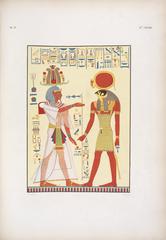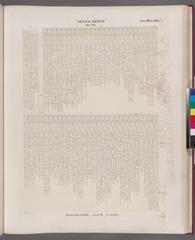
KV8 Tomb of Merenptah: Visiting Hours, Tickets, and Comprehensive Guide to this Luxor Historical Site
Date: 14/06/2025
Introduction
The Tomb of Merenptah, designated KV8, stands among the most architecturally impressive and historically significant monuments in Egypt’s Valley of the Kings near Luxor. Constructed during the Nineteenth Dynasty (circa 1213–1203 BCE), KV8 commemorates Pharaoh Merenptah, the thirteenth son and successor of Ramesses II. This tomb is notable not only for its grand scale—extending over 160 meters into the Theban cliffs—but also for its intricate wall decorations, innovative structural solutions, and its profound insights into New Kingdom funerary beliefs and practices.
This guide provides everything you need to plan a memorable visit: up-to-date information on visiting hours, ticketing procedures, accessibility, conservation status, and tips for exploring not only KV8 but the surrounding historic sites in Luxor. Whether you’re a history enthusiast, a cultural traveler, or a curious explorer, this article will help you make the most of your journey into Egypt’s ancient heritage.
Table of Contents
- Introduction
- Historical Context of KV8
- Architectural Features and Innovations
- Visiting KV8: Practical Information
- Conservation and Preservation Efforts
- Frequently Asked Questions (FAQ)
- Visual Media and Interactive Resources
- Summary and Final Tips
- References
Historical Context of KV8
The Nineteenth Dynasty and Pharaoh Merenptah
Merenptah’s reign (c. 1213–1203 BCE) was marked by efforts to maintain the empire established by his father, Ramesses II. Despite ascending the throne at an advanced age, Merenptah left a substantial legacy, including military victories against the Libyans and the “Sea Peoples.” His tomb, KV8, reflects the urgency and grandeur of royal burials during this period, serving as a key example of New Kingdom mortuary architecture and religious iconography.
Discovery and Numbering System
Located in the West Bank’s Valley of the Kings, the tomb was catalogued as KV8 in the 19th-century “Kings’ Valley” (KV) numbering system. KV8 is recognized as one of the largest tombs in the necropolis and is distinguished by both its size and its elaborate decorative program (Theban Mapping Project).
Architectural Features and Innovations
Layout and Structure
KV8 follows a straight-axis design typical of the later New Kingdom tombs, extending deep into the limestone with a series of sloping corridors and chambers. The entrance is set into the valley floor, and the tomb’s interior includes multiple corridors (A–D), two pillared halls (G and H), side chambers, a well shaft, and a vast burial chamber (J). The tomb’s layout reflects both symbolic and practical considerations, such as deep wells to deter robbers and side rooms for funerary goods (Madain Project).
The Burial Chamber and Sarcophagi
A highlight of KV8 is its immense burial chamber, originally supported by eight massive pillars (some now ruined), which housed four nested sarcophagi. The outermost sarcophagus was so large that ancient builders had to dismantle and rebuild doorjambs using inscribed sandstone blocks and dovetail cramps. The remains of Merenptah’s granite sarcophagus, although now broken, are still visible (Egyptopia).
Decorative Program
The tomb’s walls feature scenes and texts from major funerary compositions, including the Book of Gates, Book of the Dead, Amduat, and Litany of Ra. These illustrate the king’s journey through the underworld, his rebirth, and his divine status. The decoration is executed in sunk relief and painted plaster, with a vibrant palette of mineral pigments. Ceilings once displayed astronomical motifs, now partially lost to time and flooding (Goota Travel).
Visiting KV8: Practical Information
Visiting Hours and Ticket Information
- Hours: The Valley of the Kings, including KV8, is generally open daily from 6:00 AM to 5:00 PM, with last ticket sales at 4:30 PM. Hours may vary seasonally or during conservation periods (Goota Travel).
- Tickets: A general Valley of the Kings ticket grants access to three open tombs—including, typically, KV8. Additional electric shuttle tickets may be required from the visitor center to the tomb area. Tickets can be purchased onsite or in advance via the egymonuments website.
- Photography: Non-flash photography is permitted with a separate camera ticket; flash and tripods are prohibited (Earth Trekkers).
Accessibility
- Mobility: The tomb is accessed via steps and wooden walkways, with some narrow and steep sections. While improvements have been made, full wheelchair accessibility is limited. Assistance may be available at the visitor center for those with mobility challenges (Goota Travel).
- Facilities: Restrooms are located at the visitor center only; plan ahead.
Photography and Visitor Regulations
- Respect Preservation: Do not touch walls or reliefs; avoid leaning on ancient structures.
- Time Management: While no strict limits are enforced in the tomb, visitors should keep a steady pace to help reduce congestion during peak times.
Guided Tours and Travel Tips
- Guides: Official guides are available at the visitor center and can enrich your visit with expert commentary.
- Travel Tips:
- Arrive early to avoid crowds and midday heat.
- Wear sturdy shoes and comfortable clothing suitable for walking and climbing stairs.
- Bring water (not allowed inside tombs) and plan for limited shade (Intrepid Scout).
Nearby Attractions
- Other Tombs: KV62 (Tutankhamun), KV9 (Ramesses V/VI), KV11 (Ramesses III), and KV17 (Seti I) are among the most celebrated.
- Monuments: The Temple of Hatshepsut, Ramesseum, Colossi of Memnon, Luxor Temple, and Karnak Temple Complex are within reach for a full day’s exploration (Lonely Planet).
Conservation and Preservation Efforts
Current State of Preservation
KV8’s upper chambers retain vivid wall paintings, while lower corridors show signs of water and environmental damage due to occasional flash flooding. Modern interventions have installed drainage, reinforced ceilings, and improved visitor pathways. Conservationists continue to stabilize painted surfaces, address ancient and modern graffiti, and monitor temperature and humidity to preserve the delicate microclimate (Travel Hack Fun).
Ongoing Strategies
- Structural stabilization and environmental monitoring are ongoing.
- International Partnerships: Egypt’s Ministry of Antiquities, UNESCO, and the Getty Conservation Institute collaborate on digital documentation and site management.
- Visitor Management: Regulated visitor numbers, designated pathways, and periodic closures are implemented to balance public access with long-term preservation (The Discoveries Of).
Frequently Asked Questions (FAQ)
Q: What are the visiting hours for KV8?
A: Generally from 6:00 AM to 5:00 PM, with last entry at 4:30 PM. Hours may change due to conservation needs.
Q: How much are tickets for the Tomb of Merenptah?
A: The general Valley of the Kings ticket (approx. 200 EGP) includes access to three tombs; a separate camera ticket is needed for photography.
Q: Is KV8 accessible for visitors with disabilities?
A: The tomb involves stairs and uneven terrain. Some assistance may be available, but full accessibility is limited.
Q: Can I take photos inside the tomb?
A: Non-flash photography is allowed with a camera ticket. Flash and tripods are not permitted.
Q: What other sites can I visit nearby?
A: Tombs of Tutankhamun, Ramesses VI, and monuments such as the Temple of Hatshepsut and Karnak Temple are all within easy reach.
Visual Media and Interactive Resources
[Insert additional high-quality images of interior wall paintings, pillared halls, and the burial chamber. Add alt text for accessibility.]
[Embed an interactive map or virtual tour link if available.]
Summary and Final Tips
- KV8 is a masterpiece of royal tomb architecture, offering deep insight into ancient Egyptian religion and burial practices.
- Arrive early, dress comfortably, and bring water.
- Respect conservation rules: do not touch artworks, and follow photography regulations.
- Purchase your tickets in advance during peak seasons.
- Consult official resources and mobile apps like Audiala for real-time updates and guided audio tours.
By visiting KV8 with awareness and respect, you help ensure the preservation of this irreplaceable cultural landmark for future generations.
References
- Madain Project: Tombs in the Valley of the Kings
- Theban Mapping Project: KV8 Merenptah
- Travel Hack Fun: Valley of the Kings
- Goota Travel: Tomb of Merenptah
- The Discoveries Of: Valley of the Kings
- Earth Trekkers: Best Tombs in the Valley of the Kings
- Egyptopia: The Tomb of Merneptah
- Intrepid Scout: Visit Valley of the Kings
- Lonely Planet: Tomb of Merenptah
- Hurghada Lovers: Merneptah Tomb
- ETB Tours Egypt: Tomb of Merenptah
- Wikipedia: List of Burials in the Valley of the Kings
For official updates and ticketing, visit the Valley of the Kings information portal.
































































